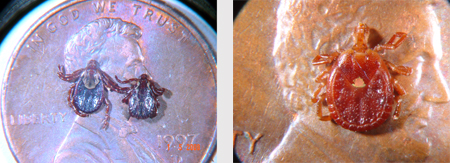Ticks get an early start
Editor’s note: This article is from the archives of the MSU Crop Advisory Team Alerts. Check the label of any pesticide referenced to ensure your use is included.
Our early spring has brought out the ticks. Most years the lab starts getting in ticks toward the end of May, but this year we received our first ticks in mid-April. People have brought in or sent us photos of both the American dog tick and the Lone Star tick.
The American dog tick, Dermacentor variabilis, is by far the most commonly encountered tick in Michigan. Both male and female American dog ticks have white markings on their backs readily distinguishes them as deer ticks. Mice appear to be the preferred hosts of immature stages of the American dog tick while the adults prefer to feed on dogs and other large mammals. Dog ticks can live for over a year without food.
The Lone Star Tick (Amblyomma americanum) gets its common name from a silvery spot supposedly shaped like Texas (to me, the spot looks more like Iowa) located on the dorsal side of the adult female. The tick is most abundant in the southeastern United States, particularly in the Ozark region and eastern Oklahoma. The tick appears to be increasing its range in the Lower Peninsula. Jill O’Donnell had one brought into the Wexford MSU Extension office this past week. The tick probably occurs throughout the Lower Peninsula. Because the mouthparts of the lone star tick are so much longer than those of the American dog tick, the bite of the lone star tick can be quite severe and often accompanied by extensive inflammation, suppuration and subsequent development of lesions.
Both ticks are most likely to be encountered in the spring and early summer along animal paths in grassy, shrubby areas adjacent to woodlots and forests. Family members and pets should be inspected daily where ticks are known to be abundant. Insect repellents may help keep wood ticks from biting, also apply duck tape around pants cuffs to keep ticks from crawling up the legs. If an attached tick is found, it should be removed by placing tweezers near the head and gently pulling it off. Be careful not to squeeze the tick as this can inject more toxins into the wound. Keep in mind that ticks cannot feed immediately after attaching. They require several hours to imbed their mouthparts deep enough to take a bloodmeal. An unfed tick (unengorged) tick is quite small and flat but a fully engorge tick looks like a small grape. Yuck! If you are unsure about the identity of your tick, save it in a vial of rubbing alcohol and send it to the lab for identification.
Neither the American dog tick or Lone Star tick is known to transmit Lyme disease and their bites rarely result in serious disease in Michigan, but both are known carriers of Rocky Mountain spotted fever and tularemia. The cases of Rocky Mountain spotted fever reported in Michigan have been from primarily southern counties, particularly those located directly north of the Toledo Airport. Also, toxins injected with their bites cause itching, fever and in some cases tick paralysis. Be on alert for any rash or fever, which are the primary symptoms of both Rocky Mountain Spotted Fever and tularemia, that develop after a tick bite.



 Print
Print Email
Email


